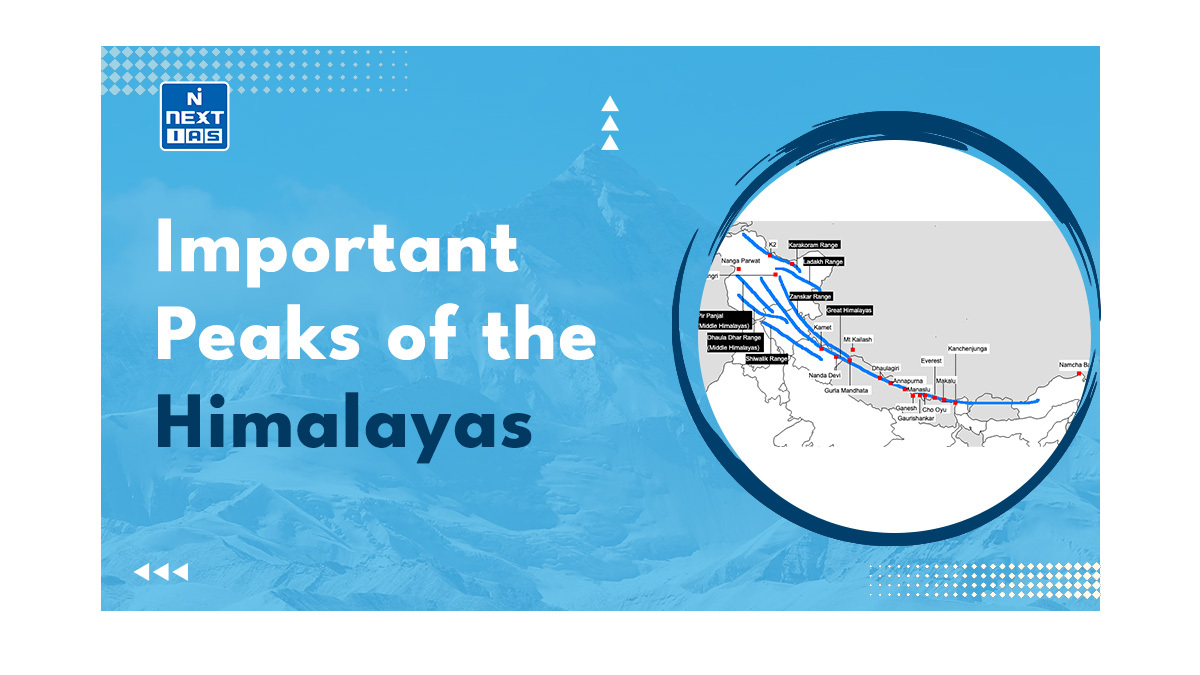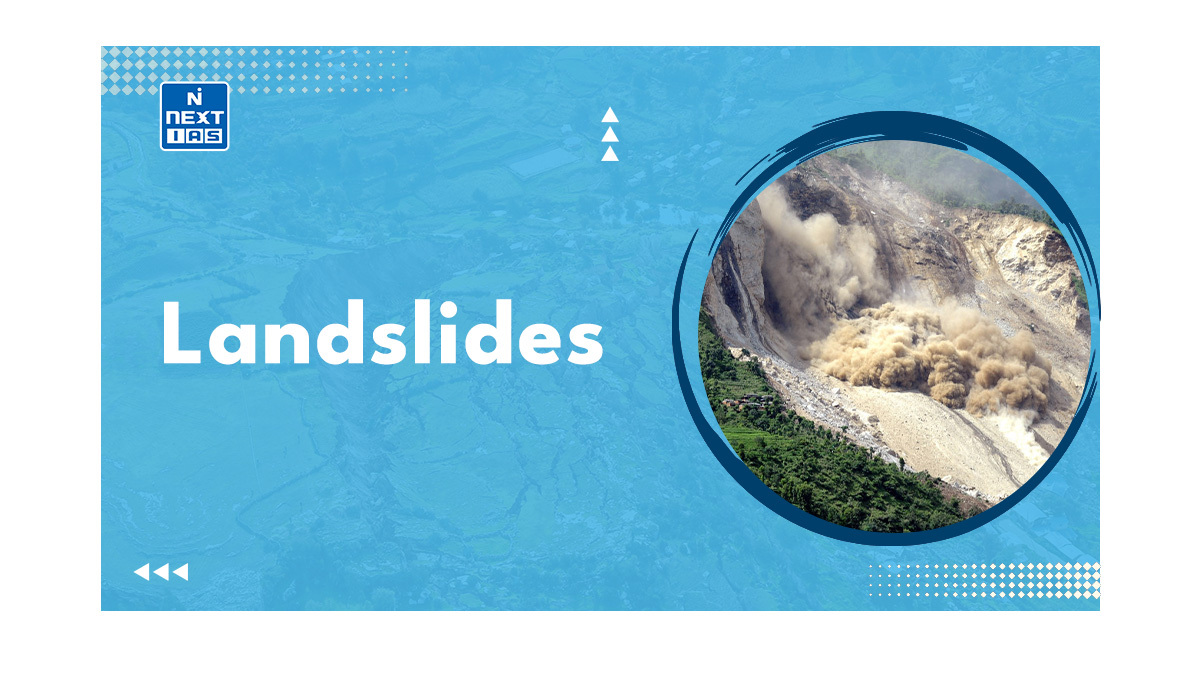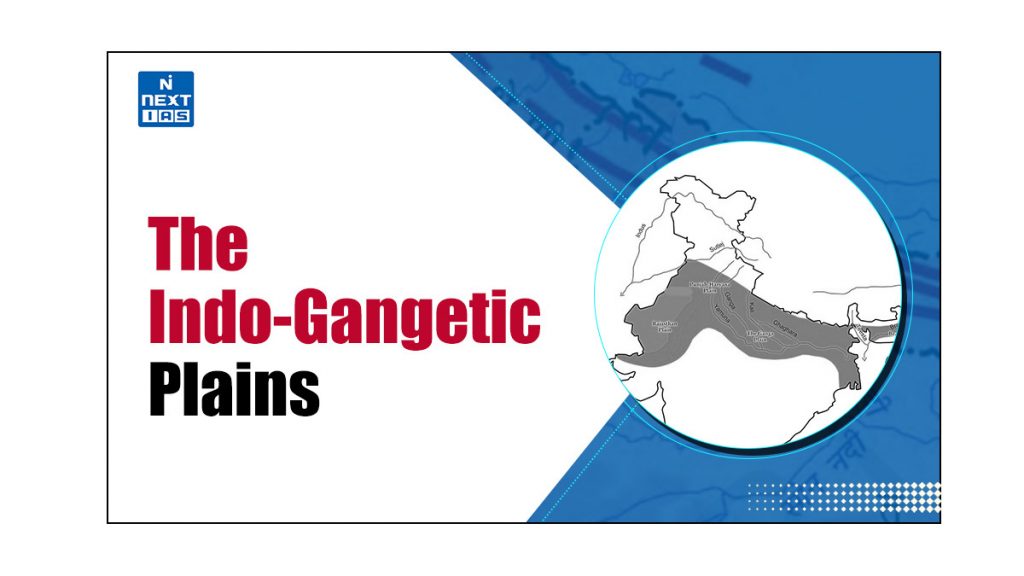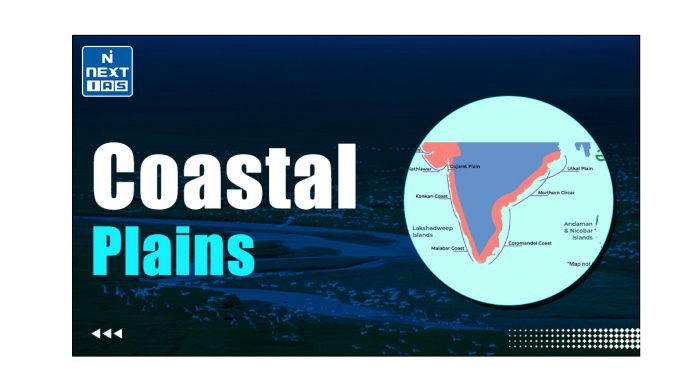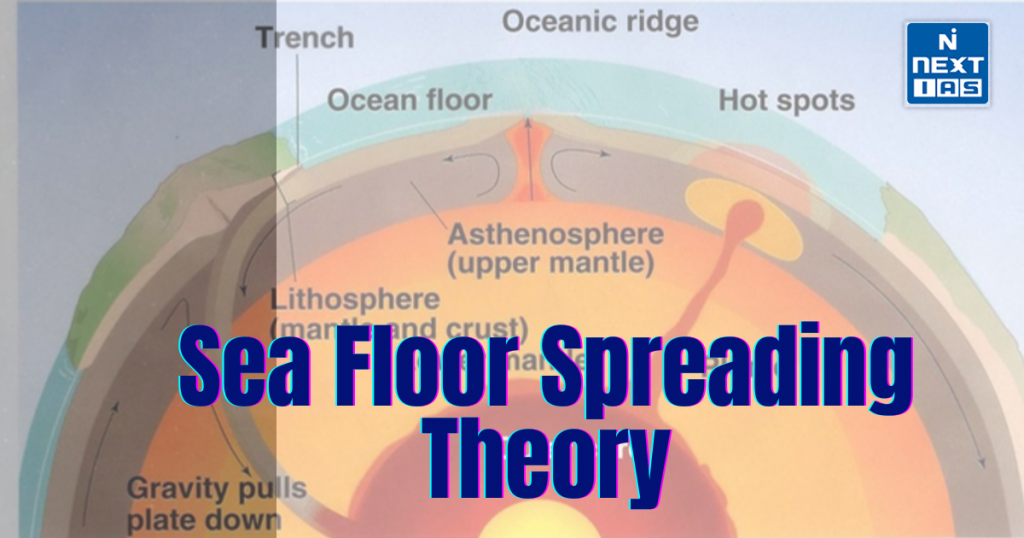
The Sea Floor Spreading Theory was proposed by Harry Hess in the 1960s. It posits that new oceanic crust is formed at mid-ocean ridges by volcanic activity and that the newly formed crust spreads outward, pushing the old crust away. Hence, tectonic plates move as oceans expand and continents drift.
About the Sea Floor Spreading Theory
- The theory of sea-floor spreading, as presented by Harry Hess in the early 1960s, teaches that at oceanic ridges, the new crust is formed and spreads outward, so there are more and more areas of the ocean floor to be laid.
- According to the theory, at such ridges, magma would be escaping from the mantle and cooling to form an oceanic crust.
- The constant influx of magma continues to push externally into the new crust and thereby drifts the older crust away from the ridge towards either side, gradually causing the “spreading” of the sea floor.
- This happens at mid-ocean ridges, along divergent plate boundaries, where plates make an attempt to separate.
- It had been the much-needed mechanism whereby continental drift was explained, implying that continents do not lie immobile but are indeed drifting with the ocean floor in some manner.
- Sea-floor spreading accounted for the symmetrical magnetic striping of rock that is found on both sides of mid-ocean ridges, lending credence to seafloor formation and reversal of Earth’s magnetic field.
- The seafloor spreading acts as a source of strength for the larger theory of plate tectonics, which governs the movement of Earth’s lithospheric plates. There have been some major research fields where our understanding of oceanography, geology, and the dynamic nature of Earth’s surface has been severely impacted.
Evidence of Sea Floor Spreading Theory
The Sea Floor Spreading Theory is substantiated by several lines of evidence validating the generation of the new oceanic crust and its outward movement from the mid-ocean ridges. Key evidence includes:
Magnetic Striping on the Ocean Floor
There are symmetrical patterns of magnetic reversal on either side of the mid-ocean ridges. Whenever a new crust is forming, it records the Earth’s magnetic field, which keeps on reversing in periods. These magnetic anomalies are symmetrical on either side of the ridge, thus proving seafloor spreading.
Age of Oceanic Crust
The oceanic crust gets older with the distance from the mid-ocean ridges. The youngest crust is that which is freshly formed at the ridges, and with any further distance, it keeps on growing older. This speaks about how crust keeps on growing at the ridges and moving out.
Seafloor Sediments Thickness
Near the mid-ocean ridges, the sediment deposits on the ocean floor are the thinnest, and they get thicker as one moves far away. This suggests that the crust near the ridges is newer and has not had much time to accumulate sediments, whereas older crust far from the ridges has accumulated considerably more.
Earthquake and Volcanic Activity
Strong earthquakes and volcanic eruptions commonly occur along the mid-ocean ridges and subduction zones-intermediate areas of seafloor spreading or of being recycled back into the mantle with older oceanic crust. These geologic activities are in accordance with the movements of tectonic plates and the creation of new oceanic crust.
Ocean Floor Mapping
Sonar mapping of the ocean floor reveals mid-ocean ridges and steep ocean trenches and faults consistent with the process of seafloor spreading. These underwater mountain ranges and rift valleys thus provide geological support evidence for the continuous formation and spreading of the crust.
Hotspots and Volcanic Chains
Formation of a volcanic island chain-first Hawaiians-give lip service to seafloor spreading. As the oceanic plate rides over a stationary hot spot, a series of volcanos form. Thus, the position of these islands relative to the moving tectonic plates is an indication of seafloor spreading.
All these lines of evidence strengthen the Sea Floor Spreading Theory and lay even more precious support to the Plate Tectonics Theory that tries to explain the movement of Earth’s crust.
Characteristics of Sea Floor Spreading Theory
Creation of New Oceanic Crust
At mid-ocean ridges, magma rises from the mantle of the Earth and, upon cooling, solidifies to create new oceanic crust. This process at mid-ocean ridges is continual and is a mechanism for new crust formation.
Movement Away from the Ridge
Newly formed crust at the ridges forces the older crust away from the ridge. The seafloor, thus, spreads with older crust situated farther away from the ridges and newer crust nearby.
Magnetic Stripes Symmetrically on Both Sides
Symmetrical patterns of magnetic anomalies exist on either side of the mid-ocean ridges of the ocean floor. The formation of new crust records the magnetic field of the Earth, which has reversed itself periodically. Thus, opposite symmetrical magnetic patterns on both sides of the ridge are witnesses to the process of seafloor spreading.
Evidence of Seafloor Aging
- The oceanic crust is youngest at the mid-ocean ridges and becomes progressively older as it moves away from them.
- This aging pattern supports the idea that new crust is continuously created at the ridges and spreads outward.
Features of Sea Floor
There exist rift valleys at mid-ocean ridges in the ocean floor, which are being pulled apart, while these valleys have a generally ring of underwater mountains around them that have resulted from the tectonic plate movement and seafloor spreading.
Plate Tectonics Connection
From a macro perspective, sea-floor spreading is an important agent in Plate Tectonics Theory, which attempts to explain the movement of lithospheric plates of Earth. The spreading of the ocean floor at the mid-ocean ridges is one expression of the divergence of tectonic plates.
Geological Activity at Boundaries
Seafloor spreading is associated with earthquakes and volcanic activity along the mid-ocean ridges and other plate boundaries. Tectonic plate movement and interactions cause these geological events.
Subduction and Recycling of Crust
Oceanic crust spreads away from the ridge until the crust sinks back into the mantle at subduction zones where material recycling takes place. This is basically balancing the formation of new crust against the destruction of old crust.
These characteristics highlight the dynamic and continuous nature of seafloor spreading, shaping Earth’s oceanic and continental features over geological time.
Significance of Sea Floor Spreading Theory
This theory of Sea-floor Spreading has heavy implications for our understanding of the geology of the Earth; the tectonic plate movements of the Earth; the very formation of the oceanic and continental features of the Earth. Among the several significances are the following:
Precursor to Plate Tectonics
Sea Floor Spreading provided some very strong lines of evidence for the development of the Plate Tectonics Theory, describing the movement of Earth’s lithospheric plates and their interactions. It allowed the concept that Earth’s surface is broken into several huge plates, all drifting.
Understanding Continental Drift
The theory gives a mechanism for continental drift, describing how continents move apart by the formation of new oceanic crust at mid-ocean ridges. This gave support to the ideas advanced by Alfred Wegener under the name Continental Drift Theory, linking the movement of continents with that of ocean floor spreading.
Developing Insight into Ocean Formation and Expansion
The theory shows that ocean basins are opening and expanding over geological time. New oceanic crust is formed continuously, thereby slowly widening ocean floors such as the Atlantic Ocean.
Evidence Supporting Earth’s Dynamic Constitution
The theory posited that the Earth is a dynamic entity with geological activities and continuous changes. It contradicted preexisting notions of a static Earth to suggest that seafloor formation and spreading are never-ending processes continuously modifying the surface of the planets.
Seismic and Volcanic Activity
Sea floor spreading gives us an account of seismic and volcanic activities. It gives an idea of how these occur at the edges of the plates, especially at mid-ocean ridges and subduction zones, literally where plates come and interact to realize geological disturbances.
Ocean Floor Mapping and Resources
The theory of sea-floor spreading went on to stimulate oceanic exploration and discerned new methods of mapping submarine features such as mid-ocean ridges, rift valleys, and deep-sea trenches. This proved a great advantage in the search for natural resources such as petroleum, gas, and minerals deposits on the ocean floor.
Advancements in Earth Sciences
- Geology, oceanography, and geophysics were revolutionized by the Sea Floor Spreading Theory.
- It contributed to the development of new research methods, such as sonar mapping, magnetometer surveys, and paleomagnetic studies, allowing scientists to study Earth’s internal structure and its dynamic processes more effectively.
Influence on Other Scientific Fields
The theory has influenced various scientific fields, including paleobiology, by providing an explanation for the distribution of fossils across different continents. It also supports studies in climatology, helping to understand how Earth’s climate has changed in response to tectonic movements over millions of years.
In summary, the Sea Floor Spreading Theory has had a profound impact on our understanding of Earth’s geological processes, contributing to the broader field of plate tectonics and providing valuable insights into the planet’s history and structure.
Way Forward
The future of the Sea Floor Spreading Theory lies considerably in intensified mapping of the ocean floor using new technologies such as deep-sea drilling and remote sensing. Further understanding of the plate tectonic system and magnetic anomalies and seismicity will enhance our knowledge of the dynamics of Earth’s processes in terms of crustal formation and crustal recycling.
Conclusion
Somehow, the Sea Floor Spreading Theory somehow has credited to reshape the understanding of the dynamic nature of Earth while providing critical support for plate tectonics. It describes the creation and movement of oceanic crust, the widening of oceans, and the interactions between tectonic plates to form modern geology and finishing far toward understanding Earth’s geological processes.
